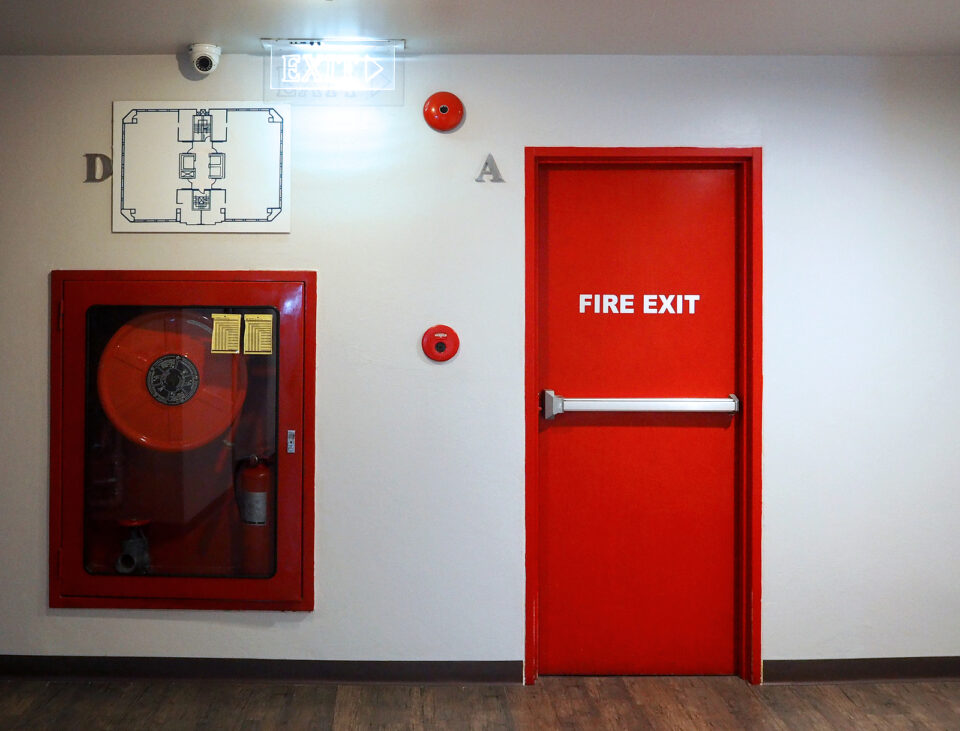Fire is a powerful and dangerous force of nature. Structure fires move quickly, they’re unpredictable, and they’re incredibly destructive. Taking steps to prevent fires from occurring is your first line of defense, but accidents are always a possibility. If you were to find yourself facing a fire at your home or business, would you know what to do?
According to U.S. Fire Administration (USFA) statistics, over the 10-year period from 2012 to 2021 there were 470,000 residential and nonresidential fires in the United States, resulting in thousands of injuries and deaths. Discovering your home or business on fire is terrifying, but with a little forethought you can avoid the worst tragedies.
Creating a fire evacuation plan for both your home and business is imperative. The Occupational Safety and Health Administration (OSHA) requires businesses to have an Emergency Action Plan (EAP), but creating one for your home is often overlooked. According to the American Red Cross, 74 percent of families haven’t practiced a fire evacuation plan, and 80 percent of Americans don’t know that house fires are the most common disaster nationwide.
Fire moves faster than many people realize. In less than a minute, a small flame can grow out of control in the dry environment of our homes and offices. Smoke quickly fills a room, creating nearly complete darkness. Toxic gasses make it difficult to breathe, and you can quickly become disoriented. The fumes and heat are far more deadly than the flames themselves, and in three to five minutes the room can become so hot that everything inside ignites at once in a deadly event known as a “flashover.”
If your fire alarm goes off, you might have only two minutes (or less) to escape. Knowing exactly what to do and where to go in this stressful situation saves precious time, and lives.
Fire evacuation planning starts with smoke alarms. The number of smoke detectors you’re required to have varies, though at minimum you need one on each level of the building (including basements and habitable attics). It’s recommended to install alarms in each sleeping space, as well as the hallways outside them. Test the units monthly, and replace batteries in traditional smoke detectors every six months. Some hassle-free modern models contain a lithium battery that lasts 10 years.
In addition to smoke alarms, fire extinguishers should also be present on each level of a home, typically placed in the kitchen. Choose multi-purpose models that can extinguish all types of fires, including flammable liquids and electrical equipment. Use a fire extinguisher only if the following is true: you are confident in your ability to use it, the fire is small with flames no taller than you are, everyone else has evacuated, and you have an open escape route behind you. If conditions worsen, escape! Life is more important than property.
Your evacuation plan begins with the layout of your home or business. Ideally each room should have at least two escapes, typically a door and a window. Draw a floor map of the building and label these places, as well as the location of each smoke alarm. Walk into each room and make sure the escape routes are not blocked or cluttered. Test windows to see that they’re easy to open. Choose a safe meeting place outside the building that everyone will know to go to, and label that on your map as well. If your building has multiple levels, obtain escape ladders for second and third stories. Escape ladders are reasonably priced and come in different styles and lengths, with most of them made to rest easily over a windowsill or railing.
The best way to prepare for a fire emergency is to run a fire drill every six months. Gather your family or employees and pretend there’s a fire. Make sure everyone knows how to call 9-1-1, and how to stop, drop, and roll. During the drill, instruct people to crawl to avoid smoke. Remember that visibility would be low, so have everyone keep their eyes closed (or wear an eye mask). If there are young or elderly people in the building, there should be designated helpers to make sure everyone is evacuated. Teach children what to do and where to go in case someone can’t get to them. Also practice closing doors when leaving a room—a closed door can delay the spread of smoke and fire significantly. Everyone should meet at the designated meeting place.
Pets are also a consideration. Know their favorite hiding places so you can get to them quickly, and have a travel container easily accessible if necessary. You can purchase specially made fire evacuation pet enclosures with rope for upper stories.
Fire suppression blankets are another useful item. They are easier to use than a fire extinguisher, and they take up very little space, so it’s reasonable to keep several around your home or business.
Apartments and many larger businesses have sprinkler systems. If yours does not, consider putting in a request to have one installed. Never use the elevator during a fire unless it is clearly marked as an emergency elevator.
If all exits are obstructed and you become trapped by a fire, close a door if possible and stuff a wet towel or clothing underneath, and also over any vents. Call 9-1-1, wave something bright, and yell for help from a window.
No one is immune to fire danger, but with a solid and practiced escape plan, everyone will be better equipped to survive the disaster.
For more information about fire evacuation planning, you can visit: ready.gov, redcross.org, osha.gov, and nfpa.org. Local resources include your nearest fire department, the Cook and Lake County Firewise program, and Valley Fire Protection in Thunder Bay.




